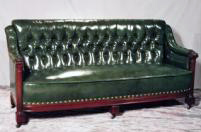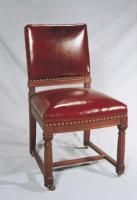Capitol Furniture InventoryThere are hundreds of custom-made pieces of furniture that adorn Pennsylvania's Capitol Building. The majority of furniture dates to the current building designed by Joseph Huston, which was completed in 1906. A few pieces even date back to the two earlier Capitol buildings: the first designed by Steven Hills (1822-1897) and the second designed by Henry Ives Cobb (1898-1901). Almost all of the furniture was originally labeled with tags before delivery and relabeled soon afterward. Desks, most of which were manufactured by the Derby Desk Company of Somerville, Massachusetts, were marked in pencil on the bottom of one of the drawers. The Derby desks also bore a manufacturer's inspection tag. Sofas had paper adhesive labels, about 4 1/2 by 3 inches, listing style, grade, length in feet and inches, and the slated original room number of each piece. Chalk markings on the bottoms of clothes trees indicated the room numbers for their placement. Besides the Derby Desk Company, several other companies also contributed to our furniture inventory: James Edwards and Company; International Manufacturing and Supply Company; Marble and Shattuck Chair Company, Cleveland, Ohio; F. Mohr and Company, New York City; Palmer and Embury, New York City; and Thonet and Brothers, New York City. An examination of Huston's 99 furniture drawings shows they are in a style best described as "American Renaissance," and thus harmonized with the general architectural style of the Capitol building. The designs employed classical details such as ornamental swags, columns, Doric, Corinthian and Ionic capitals, all applied to chairs, desks, and tables in the rather massive scale popular at the turn of the century. Huston claimed that his furniture designs matched the architectural themes prevailing in each of the major ceremonial spaces in the Capitol. Therefore, furniture for the Senate, including the barbershop, was Doric; the House was Corinthian; and the Supreme Court was Ionic. According to Huston, the Governor's suite was English Renaissance. Huston used a less ornate version of the same style in furnishing the Lieutenant Governor's rooms. As part of the preservation process, the antique furniture is cataloged in a computer database, which allows the Committee to track placement and maintenance. Each piece is tagged with a bar code so that the person using the piece can identify the agency that has been charged to care for the historic furniture. For instance, if a historic desk drawer breaks, the person using the desk will be able to call the Capitol Preservation Committee for repair or replacement of the item. The furniture inventory project encompasses all of the floors of the main Capitol building and associated Capitol Complex buildings. Examples of inventoried furniture items includes desks, chairs, sofas, clothes trees, umbrella stands, tables, benches, wardrobes, bookcases, andirons, and cabinets. |



